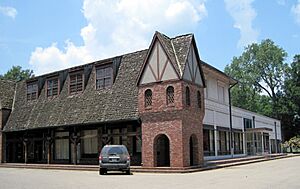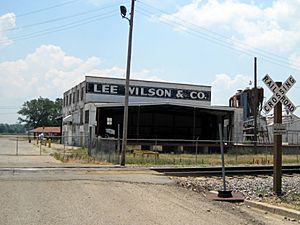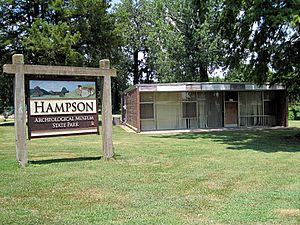Wilson, Arkansas facts for kids
Quick facts for kids
Wilson, Arkansas
|
|
|---|---|
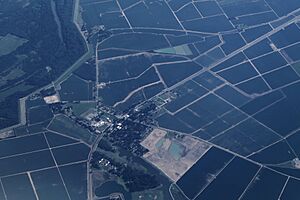
Aerial image of Wilson
|
|
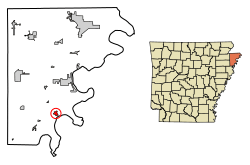
Location in Mississippi County, Arkansas
|
|
| Country | United States |
| State | Arkansas |
| County | Mississippi |
| Incorporated | March 19, 1959 |
| Area | |
| • Total | 1.05 sq mi (2.73 km2) |
| • Land | 1.05 sq mi (2.71 km2) |
| • Water | 0.01 sq mi (0.02 km2) |
| Elevation | 236 ft (72 m) |
| Population
(2020)
|
|
| • Total | 766 |
| • Density | 731.61/sq mi (282.44/km2) |
| Time zone | UTC−06:00 (Central (CST)) |
| • Summer (DST) | UTC−05:00 (CDT) |
| ZIP Code |
72395
|
| Area code(s) | 870 |
| FIPS code | 05-75920 |
| GNIS feature ID | 2405757 |
Wilson is a city in Mississippi County, Arkansas, United States. It's in the Arkansas Delta, a flat area with rich soil. Farmers there have grown a lot of cotton for a long time.
Wilson began in 1886 as a 'company town.' This means one person, Robert E. Lee Wilson, owned most of it. He built a huge cotton business from here. His company became very successful. After his son visited England in 1925, he loved the Tudor style. So, many buildings in Wilson were rebuilt to look like Tudor homes.
In 1959, Wilson officially became a city. This meant it had public roads and its own local government, not just company rules. The Wilson family owned most of the town's land and buildings until 2010. Over time, new machines helped farmers grow cotton. This meant fewer people were needed for farm work. Because of this, Wilson's population has gone down. In 2020, 766 people lived there, which was less than the 903 people in 2010.
Contents
History of Wilson
Wilson started as a company town in 1886. It was built for Robert E. Lee Wilson's nearby logging and sawmill business. The town grew when Wilson decided to use the cleared land for agriculture instead of selling it.
In 1900, an important discovery happened near Wilson. James K. Hampson found the Island 35 Mastodon, which was a huge ancient elephant.
Most people in Wilson could see company doctors for a small yearly fee. This was rare in the poor Arkansas Delta area. The company also hired people for basic services. These included drycleaning and car repair. This helped keep the standard of living high in Wilson.

After Wilson's son, Wilson Jr., and his wife came back from their England honeymoon in 1925, they loved the Tudor style. Because of this, all new public buildings were built in the Tudor style. Older public buildings were also changed to look Tudor.
The town officially became a city in 1959. This allowed houses to be sold to the people renting them. The city also started collecting taxes, which it couldn't do as a company town. As farming technology improved, fewer workers were needed. Many people moved from Wilson to find other jobs.
Geography and Location
Wilson is located in an area shaped by the Mississippi River. The land is mostly flat floodplains, with trees and fields.
The old path of the Mississippi River is still visible near the Tennessee–Arkansas state line. This is how the river looked before the big 1811–12 New Madrid earthquakes almost 200 years ago. Today, this old riverbed has shrunk. It is now small side channels of the Mississippi River. These channels may or may not connect to the main river, depending on the water level and rain.
The city is at the crossing of US Route 61 and Highway 14. The part of US 61 that goes through Wilson is part of the Great River Road. This special route helps tourists see the history of towns along the Mississippi River.
Population and People
| Historical population | |||
|---|---|---|---|
| Census | Pop. | %± | |
| 1960 | 1,191 | — | |
| 1970 | 1,009 | −15.3% | |
| 1980 | 1,115 | 10.5% | |
| 1990 | 1,068 | −4.2% | |
| 2000 | 939 | −12.1% | |
| 2010 | 903 | −3.8% | |
| 2020 | 766 | −15.2% | |
| U.S. Decennial Census | |||
The population of Wilson has changed over the years. In 1960, there were 1,191 people. By 2020, the population was 766.
2020 Census Information
In 2020, there were 766 people living in Wilson. These people lived in 355 households. About 72.85% of the people were White (not Hispanic). About 21.28% were Black or African American. A smaller number of people were Native American, or from other racial backgrounds. About 2.35% of the population was Hispanic or Latino.
Economy and Jobs
Agriculture is the main way people earn money around Wilson. Growing cotton is especially important. After slavery ended, many low-income families worked as sharecroppers. They would farm land and give a part of their crop to the landowner.
Over time, new machines like the cotton picker changed farming. These machines could do the work that many hand laborers used to do. This meant fewer people were needed for farming.
Tourism and History
The Hampson Museum State Park is in downtown Wilson. It shows a collection of ancient artifacts from early American Native American groups. These artifacts were found at the Nodena site, which is about 8 kilometers (5 miles) east of Wilson.
The museum teaches about the culture of a group of people who lived in a 15-acre (60,703 m2) palisaded village. This village was on a bend of the Mississippi River around 1400–1650 CE. The exhibits cover how these ancient people grew crops, hunted, lived their social lives, practiced religion, and managed their politics.
In 1964, the Nodena site was named a National Historic Landmark. Two years later, it was added to the National Register of Historic Places.
Education for Students
Students in Wilson can go to public schools run by the Rivercrest School District. This district used to be called the Southern Mississippi County School District. Students attend schools in the district and can graduate from Rivercrest High School.
The original Wilson school district joined with the South Mississippi district in 1968.
Images for kids
See also
 In Spanish: Wilson (Arkansas) para niños
In Spanish: Wilson (Arkansas) para niños


